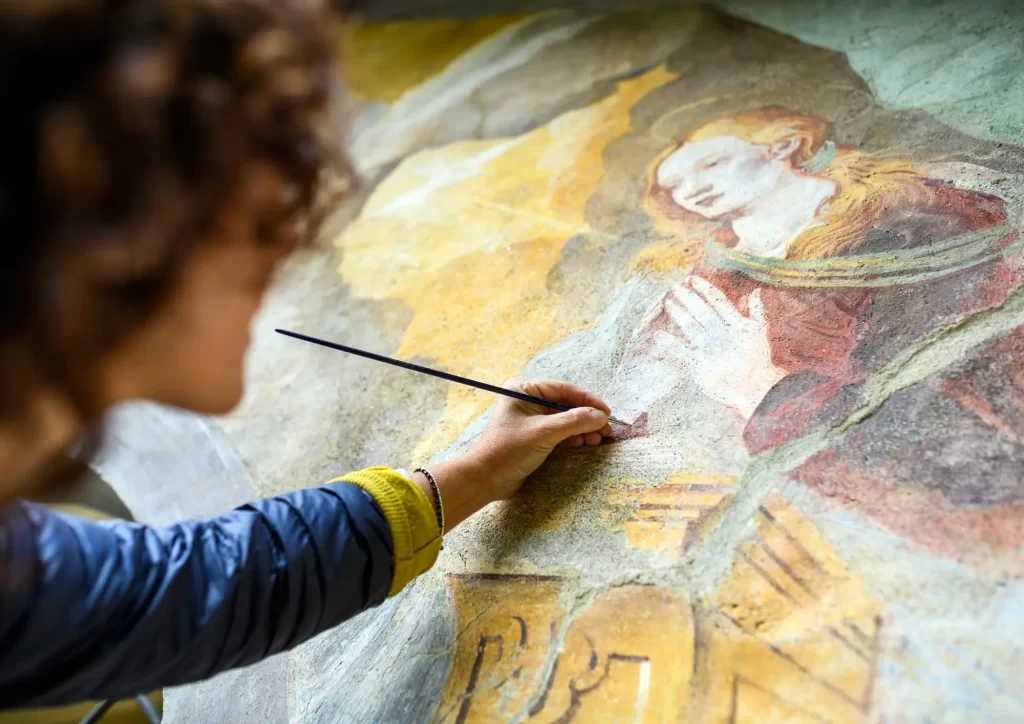Art Talks
The Art of Preservation and Restoration of Artworks

Art preservation and restoration is a meticulous and multifaceted process aimed at preserving the integrity and beauty of artworks across various mediums. Whether it’s a centuries-old oil painting, a delicate piece of textile art, or a modern sculpture, each medium requires a unique approach to address its specific conservation needs.
Oil Paintings
The restoration of oil paintings often involves several steps. Initially, conservators examine the painting using techniques like ultraviolet light and infrared reflectography to identify underlying issues such as previous restorations, cracks, and varnish layers. Cleaning is a crucial part of the process, where conservators carefully remove dirt, grime, and old varnish using gentle solvents. Following cleaning, damaged areas are stabilized, and any missing or flaked paint is meticulously inpainted to match the original work. A final layer of varnish is applied to protect the painting and enhance its appearance.
Watercolor
Restoring watercolors requires a more delicate touch due to the sensitivity of the paper and pigments. The process typically starts with a thorough examination to assess any issues such as discoloration, tears, or mold. Conservators might use humidification and flattening techniques to correct warping. Surface cleaning is done using soft brushes and specialized erasers to remove surface dirt. In cases where the paper is stained, gentle bleaching solutions may be used, followed by repairs to any tears or losses with Japanese tissue and wheat starch paste.
Stone Sculptures
Stone sculptures, often exposed to the elements, can suffer from surface erosion, cracks, and biological growth. Restoration begins with a detailed assessment, followed by cleaning using methods such as laser cleaning, micro-abrasive techniques, or chemical poultices to remove surface contaminants. Structural repairs involve consolidating weakened areas with compatible materials and filling cracks with specially formulated resins or mortar. In cases where parts of the sculpture are missing, conservators may use materials like plaster or resin to create fills that match the original stone.
Metal Sculptures
The restoration of metal sculptures, particularly those made of bronze or iron, often involves addressing corrosion. Conservators start by mechanically or chemically removing corrosion products. For bronze sculptures, a protective patina is sometimes reapplied to match the original appearance. Structural stabilization is achieved by welding or soldering broken parts, and a protective coating is applied to prevent future corrosion.
Historical Tapestries and Fabrics
Textile conservation is particularly intricate due to the fragility and complexity of the materials. The process begins with a thorough inspection to identify areas of weakness, staining, or insect damage. Cleaning is typically done using vacuum suction through a screen or gentle wet cleaning methods. Structural repairs include reweaving, stitching, or patching areas of loss with compatible fabrics. Conservators often use support linings to stabilize the textile and prepare it for display.
Drawings and Prints
Paper-based artworks, like drawings and prints, are vulnerable to factors like acidification, tears, and foxing. The restoration process starts with a detailed examination, followed by surface cleaning using soft brushes and erasers. Acidification is addressed by washing the paper in a mild alkaline solution to neutralize acids. Tears and losses are repaired using Japanese tissue and wheat starch paste, and deacidification treatments may be applied to ensure long-term stability.
Preserving, and even more so restoring, art is a meticulous blend of scientific techniques, skilled craftsmanship, and deep historical knowledge. Each medium presents unique challenges that require specialized knowledge and techniques. By understanding and employing these processes, conservators ensure that our cultural heritage is preserved for future generations to appreciate and study.
Written by Cherry Fulgar
For more information, contact Imahica Art at +63 917 894 5646, or email thegallery@imahica.art
Imahica Art is a contemporary art gallery in the Philippines, showcasing works by both emerging and established artists. As one of the newest venues in the Philippines, it significantly enhances the diversity and appreciation of contemporary art collections and investments, both locally and globally. Located at the intersection of Lee Street and Shaw Boulevard in Wack-Wack, Mandaluyong City, the gallery is fully accessible and open to the public for free unless otherwise stated.

